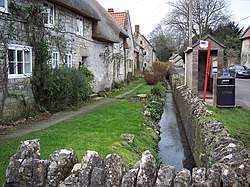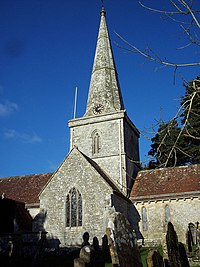Chilmark
| Chilmark | |
| Wiltshire | |
|---|---|
 Chilmark | |
| Location | |
| Grid reference: | ST969327 |
| Location: | 51°5’38"N, 2°2’42"W |
| Data | |
| Population: | 525 (2011) |
| Post town: | Salisbury |
| Postcode: | SP3 |
| Dialling code: | 01722 |
| Local Government | |
| Council: | Wiltshire |
| Parliamentary constituency: |
South West Wiltshire |
Chilmark is a petty little Wiltshire village of some 150 houses straddling the B3089 road in the south of the county, eleven miles west of Salisbury,[1] The wide parish includes the hamlets of Mooray and Portash, both close to the south of Chilmark village; and the dispersed hamlet of Ridge, to the south-west.
The stream through the village, often dry in summer, flows some two miles south to join the River Nadder. The Fonthill estate extends into the west of the parish as far as Ridge.[2]
Contents
History
Roman artefacts have been found in the nearby quarries, and Purbeck limestone, possibly from Chilmark, was used in the construction of Roman mansions at the villages of West Grimstead and Rockbourne Villa.[3]
There was probably a church at Chilmark in the 12th century.[4] Chilmark Manor, a house near the church, is a 17th-century building with 18th-century alterations.[5]
Churches
The Church of St Margaret of Antioch, Chilmark's parish church, dates from the 13th century, with additions in the 14th and 18th centuries. It was most recently restored in 1856 by T.H. Wyatt. The steepled tower, rebuilt in about 1770, retains 13th-century lancet windows.
The font has an original 13th-century bowl on a 19th-century base. The church contains several stained-glass windows from the 19th century. It is a Grade II* listed building.[6]
The churchyard has Grade II listed chest tombs from the 17th and 18th centuries.
A small Baptist chapel was built at Ridge at some time between 1851 and 1864, later becoming known as the Union chapel.[4] By 2003, the building was in private hands.
Chilmark Ravine
About a mile south of the village, the stream passes (together with a minor road) through a ravine, as it descends into the Nadder valley. Stone was quarried here from mediæval times, and in the 20th century the ravine was the site of defence establishments. The western half of this area is in Teffont civil parish.
Quarries
Chilmark stone, a form of limestone, was quarried here and used for buildings including Salisbury Cathedral. Stone extraction continued on a small scale until the quarry closed around 2007. Similar stone is still mined at Chicksgrove Quarry, a mile and a half to the south-west.[7] The former quarries have been designated as a Site of Special Scientific Interest (biological and geological), and as a European Special Area of Conservation for their bat population.
RAF Chilmark
In 1936 the quarries, and land extending further down the ravine, were bought by the Air Ministry and the site became RAF Chilmark, which was the home of No. 11 Maintenance Unit RAF.[4] Munitions were stored in the quarry caverns, and for a time the unit had extensive above-ground storage areas in woodland near Dinton and in Grovely Wood.
A spur left the London-Exeter railway west of Dinton station at Ham Cross, just east of the bridge over the Chicksgrove-Fovant road, and entered the foot of the ravine: this spur was omitted from Ordnance Survey maps. Goods were transhipped under cover of a large shed, to/from a 2-ft gauge narrow-gauge railway which ran into the ravine and some of the former quarry caverns.[8] Until c.1951, sidings at Wylye station on the Salisbury–Westbury line provided transport for the Grovely Wood area.[9]
By 1965, Chilmark was the RAF's only ammunition supply depot.[10] RAF Chilmark closed in 1995, although clearance of explosives from the site continued until at least 1997.[11] A 1939 diesel locomotive used at the site was bought in 1976 by the Bala Lake Railway in Merrionethshire;[12] several wagons are at the Old Kiln Light Railway in Surrey.
Civil defence bunker
An underground bunker was built in the ravine in 1985, ready to act as the Regional Government Headquarters (RGHQ) for the southwest region in the event of a nuclear attack. It ceased to be operational in 1992, following the end of the Cold War, and was sold in 1997.[13][14]
During the night of 22 February 2017, officers from Wiltshire Police raided the bunker following information received that it had been converted for use as a massive cannabis farm: there are approximately 20 rooms in the building, split over two floors, each 200 feet long and 70 feet wide. Almost every room had been converted for the wholesale production of cannabis plants, and there was a large amount of evidence of previous crops. The farm was estimated to be able to produce £2 million worth of cannabis per year using £250,000 worth of stolen electricity, with a crop of 4,000 plants every six weeks. The lighting equipment alone was estimated to have cost about £140,000. It took ten days to search and clear the site, which was said to be the biggest cannabis factory found in the West Country.[15] Custodial sentences were imposed on the three men in August 2017.
About the village
The village has one pub, the Black Dog Inn.
The village has a primary school, Chilmark and Fonthill Bishop CofE (Voluntary aided) Primary School: this began as a National School, built in Chilmark stone in 1860.
The Reading Room of 1910 is now the village hall.[16]
Outside links
| ("Wikimedia Commons" has material about Chilmark) |
References
- ↑ Information on Chilmark from GENUKI
- ↑ National Heritage List 1000322: Fonthill landscape park (Register of Historic Parks and Gardens)
- ↑ Sawyer, R., Nadder, 2006, p.84, The Hobnob Press, ISBN 978-0-946418-53-4
- ↑ 4.0 4.1 4.2 A History of the County of Wiltshire - Volume 13 pp 114-125: Parishes: Chilmark (Victoria County History)
- ↑ National Heritage List 1146281: Chilmark Manor with gatepiers (Grade II listing)
- ↑ National Heritage List 1318662: Church of St. Margaret of Antioch (Grade II* listing)
- ↑ "Chicksgrove Stone". Lovell Stone Group. http://www.chicksgrovequarry.co.uk/. Retrieved 29 March 2016.
- ↑ "Chilmark (includes photograph of transshipment shed)". Subterranea Britannica. http://www.subbrit.org.uk/rsg/sites/c/chilmark/. Retrieved 29 March 2016.
- ↑ Oakley, Mike (2004). Wiltshire Railway Stations. Wimbourne: The Dovecote Press. pp. 154–155. ISBN 1-904349-33-1.
- ↑ National Monuments Record: No. 1538887 – RAF Chilmark
- ↑ "Journal of the Royal Air Force Historical Society vol 35". 2005. pp. 62–63. http://www.rafmuseum.org.uk/documents/Research/RAF-Historical-Society-Journals/Journal-35-Seminar-Supply.pdf. Retrieved 30 March 2016.
- ↑ "Locomotives". Bala Lake Railway. http://www.bala-lake-railway.co.uk/stock/default.html. Retrieved 29 March 2016.
- ↑ Fox, Steven (2004). "Struggle for Survival: The Regional Government Headquarters". Subterranea Britannica. http://www.subbrit.org.uk/rsg/features/sfs/file_11.htm. Retrieved 29 March 2016.
- ↑ McCamley, Nick (2013). Cold War Secret Nuclear Bunkers: The Passive Defence of the Western World During the Cold War. Pen and Sword Books. pp. 184–187. ISBN 9781473813243.
- ↑ Press Association (10 June 2017). "Three men admit converting nuclear bunker into huge cannabis factory". https://www.theguardian.com/society/2017/jun/09/three-men-admit-converting-nuclear-bunker-into-huge-cannabis-factory. Retrieved 10 June 2017.
- ↑ "Chilmark Reading Room". http://www.chilmarkreadingroom.co.uk. Retrieved 30 March 2016.
